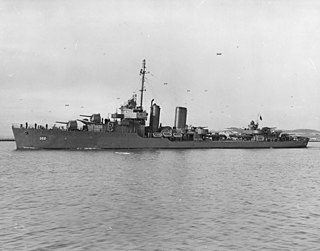
USS Pensacola (CL/CA-24) was a cruiser of the United States Navy that was in service from 1929 to 1945. She was the lead ship of the Pensacola class, which the navy classified from 1931 as heavy cruisers. The third Navy ship to be named after the city of Pensacola, Florida, she was nicknamed the "Grey Ghost" by Tokyo Rose. She received 13 battle stars for her service.

The third USS Farragut (DD-348) was named for Admiral David Glasgow Farragut (1801–1870). She was the lead ship of her class of destroyers in the United States Navy.

Mahan-class destroyers of the United States Navy were a series of 18 destroyers of which the first 16 were laid down in 1934. The last two of the 18, Dunlap and Fanning, are sometimes considered a separate ship class. All 18 were commissioned in 1936 and 1937. Mahan was the lead ship, named for Rear Admiral Alfred Thayer Mahan, an influential historian and theorist on sea power.

USS Hazelwood (DD-531) was a World War II-era Fletcher-class destroyer in the service of the United States Navy The ship was the second named for Commodore John Hazelwood; a naval leader in the American Continental Navy.

USS Jenkins (DD-447) was a Fletcher-class destroyer in the service of the United States Navy, the second ship named after Rear Admiral Thornton A. Jenkins. Beginning service during World War II, the destroyer saw action in the Pacific theatre. Jenkins was placed in reserve following the end of the war, until 1951, when the ship was reactivated for the Korean War. She served in the western Pacific until 1969 when the destroyer was taken out of service and sold for scrap in 1971.

USS Helm (DD-388) was a Bagley-class destroyer in the United States Navy during World War II. She was named for Rear Admiral James Meredith Helm. Helm received 11 battle stars for her World War II service in the Pacific.

USS Ralph Talbot (DD-390) was a Bagley-class destroyer in the United States Navy, named for USMC Second Lieutenant Ralph Talbot (1897–1918), who was awarded the Medal of Honor during World War I. Talbot served in the Pacific Theater during World War II, from the attack on Pearl Harbor through the battle of Okinawa, earning 14 battle stars for her service.

USS O'Flaherty (DE-340) was a John C. Butler-class destroyer escort built for the United States Navy during World War II. She was named for Ensign Frank Woodrow O'Flaherty, a pilot who posthumously received the Navy Cross for his actions at the Battle of Midway.

USS Stafford (DE-411) was a John C. Butler-class destroyer escort in the United States Navy. She was named after Richard Y. Stafford (1916–1942), a United States Marine Corps Captain who died during the Battle of Guadalcanal.

USS Hale (DD-642), a Fletcher-class destroyer, was the second ship of the United States Navy to be named for Maine Senator Eugene Hale (1836–1918).

USS Williamson (DD-244/AVP-15/AVD-2/APD-27) was a Clemson-class destroyer in the United States Navy during World War II. She was named for Commander William Price Williamson.

USS Schroeder (DD-501), a Fletcher-class destroyer, was a ship of the United States Navy, named for Rear Admiral Seaton Schroeder (1849–1922). Entering service in 1943, the ship saw action during World War II, participating in the Battle of Tarawa. Following the war the destroyer was placed in reserve, remaining in this state until 1972. She was sold for scrap in 1974.

USS Grayson (DD-435), a Gleaves-class destroyer, is the only ship of the United States Navy to be named for Rear Admiral Cary Travers Grayson, who served as personal physician and aide to President Woodrow Wilson during World War I. He also served as chairman of the American Red Cross from 1935 until his death on 15 February 1938.

The third USS Macdonough (DD-351) was a Farragut-class destroyer in the United States Navy during World War II. She was named for Thomas Macdonough.

The third USS Worden (DD-352) was a Farragut-class destroyer in the United States Navy during World War II. She was named for John Lorimer Worden.

USS Patterson (DD-392), a Bagley-class destroyer, was the second ship of the United States Navy to be named for Daniel Todd Patterson, an officer of the US Navy who served in the Quasi-War with France, First Barbary War, and the War of 1812.

USS Fanning (DD-385) was a Mahan-class destroyer, in the United States Navy named for Nathaniel Fanning. Her first action was during World War II, immediately following the 7 December 1941 attack on Pearl Harbor. Fanning continued to serve in the Pacific Theatre throughout the war, and was decommissioned 14 December 1945. She was one of the last Mahan-class destroyers. Fanning and USS Dunlap were built from the same basic Mahan design but slightly modified. Some sources refer to them as the Dunlap-class destroyers.

The second USS McCall (DD-400) was a Gridley-class destroyer in the United States Navy named after Captain Edward McCall, an officer in the United States Navy during the War of 1812. Launched in 1937, she saw service throughout World War II, including in the Guadalcanal Campaign, Battle of the Philippine Sea, and other battles, earning 9 battle stars for her service. She was struck from the rolls in 1947 scrapped the following year.

The second USS Maury (DD-401) was a Gridley-class destroyer in the United States Navy. She was named for Matthew Maury, and was one of the most decorated US Naval vessels of World War II.

USS McCoy Reynolds (DE-440) was a John C. Butler-class destroyer escort acquired by the U.S. Navy during World War II. The primary purpose of the destroyer escort was to escort and protect ships in convoy, in addition to other tasks as assigned, such as patrol or radar picket. Post-war, after operating in the Pacific Ocean battle areas, her crew members returned home with four battle stars to their credit for World War II and one for the Korean War.




















